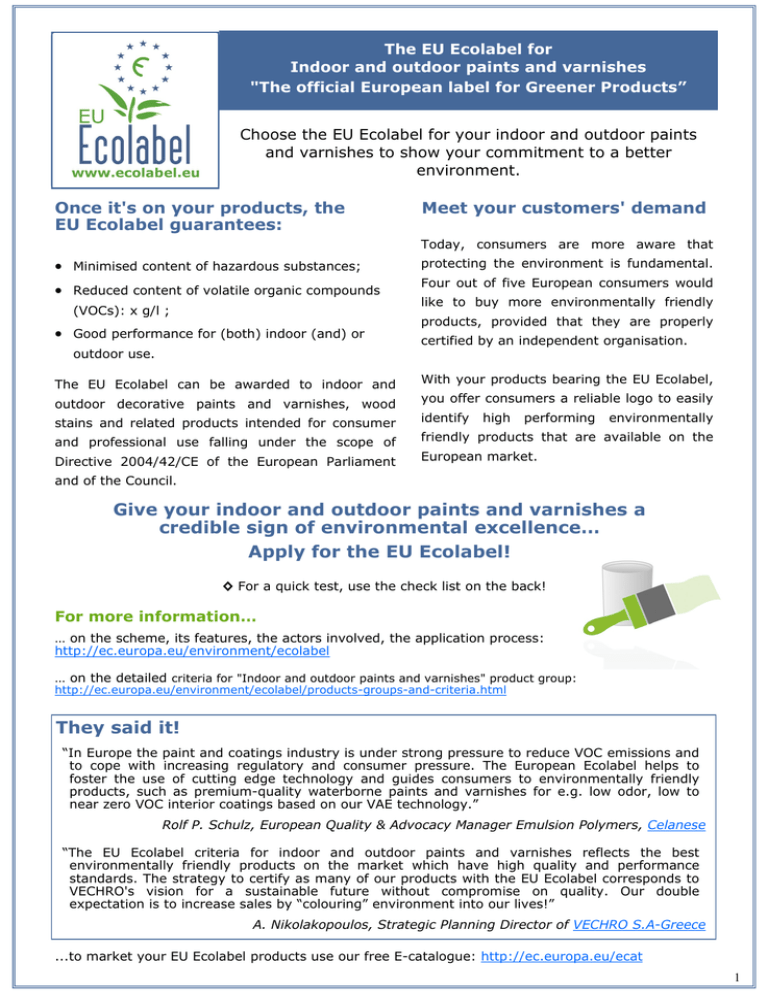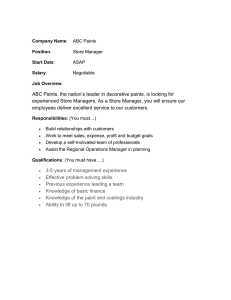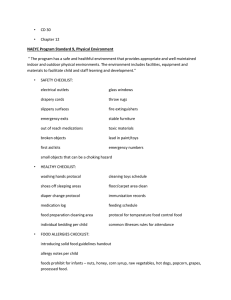Paints and Varnishes
advertisement

The EU Ecolabel for Indoor and outdoor paints and varnishes "The official European label for Greener Products” Choose the EU Ecolabel for your indoor and outdoor paints and varnishes to show your commitment to a better environment. Once it's on your products, the EU Ecolabel guarantees: Meet your customers' demand Today, consumers are more aware that Minimised content of hazardous substances; protecting the environment is fundamental. Reduced content of volatile organic compounds Four out of five European consumers would (VOCs): x g/l ; Good performance for (both) indoor (and) or outdoor use. The EU Ecolabel can be awarded to indoor and outdoor decorative paints and varnishes, wood stains and related products intended for consumer and professional use falling under the scope of Directive 2004/42/CE of the European Parliament like to buy more environmentally friendly products, provided that they are properly certified by an independent organisation. With your products bearing the EU Ecolabel, you offer consumers a reliable logo to easily identify high performing environmentally friendly products that are available on the European market. and of the Council. Give your indoor and outdoor paints and varnishes a credible sign of environmental excellence… Apply for the EU Ecolabel! ◊ For a quick test, use the check list on the back! For more information… … on the scheme, its features, the actors involved, the application process: http://ec.europa.eu/environment/ecolabel … on the detailed criteria for "Indoor and outdoor paints and varnishes" product group: http://ec.europa.eu/environment/ecolabel/products-groups-and-criteria.html They said it! “In Europe the paint and coatings industry is under strong pressure to reduce VOC emissions and to cope with increasing regulatory and consumer pressure. The European Ecolabel helps to foster the use of cutting edge technology and guides consumers to environmentally friendly products, such as premium-quality waterborne paints and varnishes for e.g. low odor, low to near zero VOC interior coatings based on our VAE technology.” Rolf P. Schulz, European Quality & Advocacy Manager Emulsion Polymers, Celanese “The EU Ecolabel criteria for indoor and outdoor paints and varnishes reflects the best environmentally friendly products on the market which have high quality and performance standards. The strategy to certify as many of our products with the EU Ecolabel corresponds to VECHRO's vision for a sustainable future without compromise on quality. Our double expectation is to increase sales by “colouring” environment into our lives!” A. Nikolakopoulos, Strategic Planning Director of VECHRO S.A-Greece ...to market your EU Ecolabel products use our free E-catalogue: http://ec.europa.eu/ecat 1 Checklist (for a first assessment only) in terms of requirements This is a non-exhaustive list of EU Ecolabel criteria for indoor and outdoor paints and varnishes. Please see the Commission Decision(2014/312/EU) for full details. Life cycle step Manufacturing Expectations Criterion Criterion 1. White pigment and wet scrub resistance Indoor wall and ceiling paints with class 1 wet scrub resistance claims, the white pigment content is restricted to 40 g/m2 per m2 of dry film with 98% opacity. For those with class 2 wet scrub resistance claims, the white pigment content is restricted to 36 g/m2. For all other paints, the white pigment content (white inorganic pigments with a refractive index higher than 1,8) shall not exceed 36 g/m2 for indoor products and 38 g/m2 for outdoor products. All tinting base indoor wall and ceiling paints shall achieve class 1 or 2 in wet scrub resistance. Exempted from this requriement are those with a white pigment content equal or less than 25 g/m2 of dry film with 98% opacity. Manufacturing Criterion 2. Titanium dioxide pigment Products containing more than 3,0 % w/w of titanium dioxide, the value limits for the emissions and discharges of wastes from the production of any titanium dioxide pigment used are listed in the full criteria document. Manufacturing Criterion 4. Content of volatile and semi-volatile organic compounds (VOCs, SVOCs) The value limits for Volatile Organic Compounds (VOCs) and Semi-Volatile Organic Compound (SVOCs) are indicated in table 3 of the full criteria document. The content of VOCs and SVOCs shall be formulated according to the ready-to-to-use product and shall include any recommended additions before applying colourants and/or thinners. Criterion 5. Restriction of hazardous substances and mixtures Details on the overall restrictions to hazard classifications and risk phrases can be found in the full criteria document. In accordance with Regulation (EC) No 1272/2008 or Directive 67/548/EEC, the final product shall not be classified and labelled as being: acutely toxic, a specific target organ toxicant, a respiratory or skin sensitiser, or carcinogenic, mutagenic or toxic for reproduction hazardous to the environment. The list of defined groups of substances that are granted derogations as well as the derogation conditions applying to production sites can be found in the full criteria document. The final product, any ingredients, and raw materials shall not, unless mentioned under derogations, contain substances that meet the criteria in Article 57 of the REACH regulation. The same holds for substances identified as substances of very high concern in Article 59 of the REACH Regulation. Manufacturing Use Criterion 3. Efficiency in use Use Consumer information Use Information appearing on the EU Ecolabel Table 2 of the full criteria document lists the performance requirements demonstrating use efficiency. At a 98% hiding power, white paints and light-coloured paints (including finishes and intermediates) shall have a spreading rate of at least 8 m2 per litre of product for indoor paints and 6 m2 for outdoor paints. This criterion only applies to white base tinting systems. Other requirements on the minimum spreading rate can be found in the full criteria document. Neither the product’s gloss nor the colour shall be changed when exposed to water for a duration of 24 hours with a 16 hour recovery. Required results for the EN 24624 (ISO 4624) pull-of test are listed in the full criteria document. The abrasion resistance shall not exceed 70 mg weight loss after 1000 test cycles according to EN ISO 7784-2. When exposed to artificial weathering according to ISO 11507 or EN 927-6, the product shall meet the requirements specified in the full criteria document. When claiming that the paint is breathable, the base paint of the product shall be classified according to EN1062-1 as class II or better according to test method EN ISO 7783. Claiming that exterior masonry and concrete paints are water repellent or elastomeric requires a class III (low liquid permeability) classification, according to method EN 1062-3 for the base paint. All other masonry paints shall be classified as class II or better. The requirements for exterior masonry finish and wood paints claimed to be anti-fungal and algal properties, and in accordance with PT7 of the Biocide Regulation (EU) No 528/2012 of the European Parliament and of the Council are indicated in the full criteria document. The base paint shall be at least classified as A1 according to EN 1062, when claiming that the masonry (or concrete) paint has elastomeric properties. Masonry paints and primers shall show no noticeable damage when tested according to method ISO 2812-4. For simulated corrosion stresses applying test procedures specified in EN ISO 12944-6, results shall not be worse than size 3 and density 3 in blistering and not worse than Ri2 in rusting tests (rated according to ISO 4628-2 for blistering and ISO 4628-3 for rusting). The following information shall be included on the packaging: Minimise paint wastage by estimating how much paint you will need Recover unused paint for re-use Reuse of paint can effectively minimise the products' life cycle environmental impact General information and advice on how to handle and use the paint shall be provided. The optional label with text box shall contain the following text: Minimised content of hazardous substances Reduced content of volatile organic compounds (VOCs): x g/l Good performance for indoor use (where indoor criteria have been met) or Good performance for outdoor use (where outdoor criteria have been met) or Good performance for both indoor and outdoor use (where both indoor and outdoor criteria have been met) The use of the optional label with the text box is explained in the "Guidelines for the use of the EU Ecolabel logo". 2


